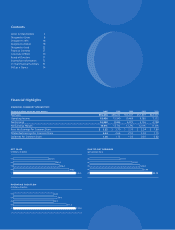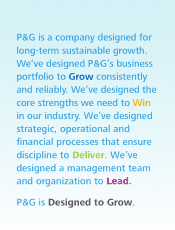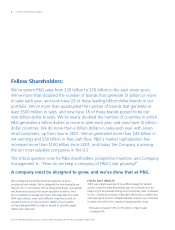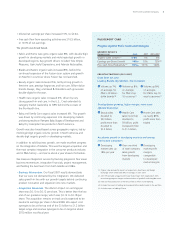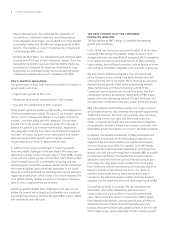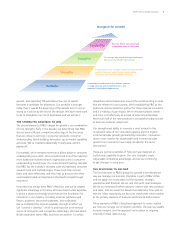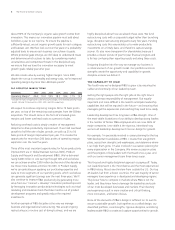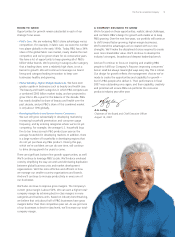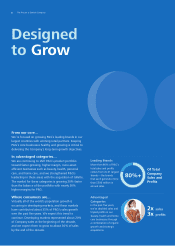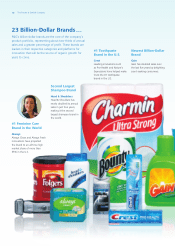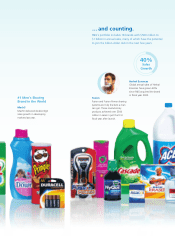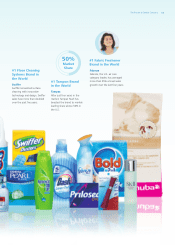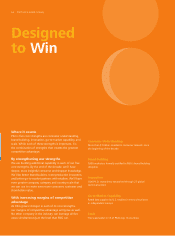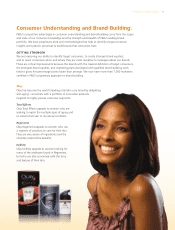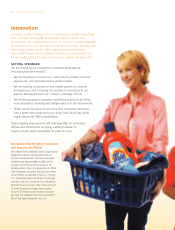Proctor and Gamble 2007 Annual Report Download - page 8
Download and view the complete annual report
Please find page 8 of the 2007 Proctor and Gamble annual report below. You can navigate through the pages in the report by either clicking on the pages listed below, or by using the keyword search tool below to find specific information within the annual report.
About 90% of the Company’s organic sales growth comes from
innovation. This means our innovation pipeline must add about
$4 billion a year to our top line. To ensure the pipeline is
sufciently robust, we set organic growth goals for each category
and business unit. We then look out over ve years on a probability-
adjusted basis to ensure each business can achieve its goals.
Where potential gaps emerge, we drill deep to understand issues
and determine which actions to take. By considering market
uncertainties and competitive threats in this disciplined way,
we ensure that we have the innovation necessary to meet
growth goals reliably year after year.
We also create value by earning higher margins. Since 2001,
despite the run-up in commodity and energy costs, we’ve improved
operating margins by more than 400 basis points*.
&
(percentage) 2006 2005 2004 2003 2002 2001
Operating Margin* 19.4 18.5 18.3 18.6 17.5 15.5
* Excludes the impact of Organization 2005 restructuring charges, which reduced operating margin
by 460, 240 and 170 basis points in 2001, 2002, and 2003, respectively.
We expect to continue improving margins 50 to 75 basis points
per year, on top of the remaining cost synergies from the Gillette
acquisition. This should come in the form of increased gross
margins and lower overhead costs as a percent of sales.
Reducing overhead costs is simply a matter of management
discipline to drive productivity improvement. If we hold overhead
growth to half the rate of sales growth, we pick up 25 to 50
basis points of margin improvement per year. This creates the
opportunity for more than 200 basis points of operating margin
expansion over the next ve years.
Three of the most important opportunities for future productivity
improvement are in Global Business Services (GBS), Product
Supply and Research and Development (R&D). We’ve delivered
nearly $400 million in cost savings through GBS and we believe
we can achieve another $300 million by the end of the decade as
we move more business activities into GBS. In Product Supply,
we’re concentrating on applying our purchasing expertise and
scale to more segments of our spending pools, which we believe
can generate signicant savings over the next three years. We’ll
also continue to improve R&D productivity by generating more
value from our “connect + develop” innovation partnerships and
by leveraging innovation productivity technologies such as virtual
modeling and simulation tools that take months out of product
development programs and greatly reduce the required
investments.
Another example of P&G discipline is the way we manage
business and organizational restructuring. We accept ongoing
restructuring as a routine cost of doing business, and we are
highly disciplined about how we absorb these costs. We fund
restructuring costs with a corporate budget rather than launching
large, disruptive restructuring programs every few years. Funding
restructuring costs this way enables us to make productivity
investments on a timely basis, and therefore capture savings
sooner. It’s also more transparent for shareholders because it
provides a clearer picture of year-to-year nancial progress and
is far less confusing than reporting results excluding these costs.
Designing discipline into the way we manage our business is
a critical element of our growth model. Our portfolio and core
strengths create the opportunity and capability for growth;
discipline ensures we deliver it.
The fourth way we’ve designed P&G to grow is by ensuring the
caliber and continuity of our leadership team.
Getting the right people into the right jobs at the right time is
always a primary responsibility of management. But equally
important and more difcult is the need to anticipate leadership
capabilities that will be required in the future
—
and ensuring that
managers get the experiences and coaching they need to be ready.
Leadership development has long been a P&G strength. One of
the most visible illustrations of our ability to develop strong leaders
is the number of former P&G employees who are now CEOs of
major companies. Less visible is the rigorous, intentional way
we’ve built leadership development into our design for growth.
For example, I’m personally involved in career planning for the top
500 development candidates at P&G. I review their assignment
plans, assess their strengths and weaknesses, and determine where
I can help them grow. I’m also involved in succession planning for
every organization in the Company. We review succession plans
and the progress of key leaders with the Board once a year, and
with our senior management team three times a year.
This focused and highly disciplined approach is paying off. Today,
our leadership team is the most diverse and the most experienced
in P&G history. About one-third are from outside the U.S. Our top
45 leaders hail from a dozen countries. The vast majority of senior
managers have experience in developed and developing regions.
They know how to compete in markets where P&G is not the
leader, and they know how to leverage the leadership and scale
of our most developed businesses and markets. Their diversity
and experience result in more creative and critical thinking,
more innovation, and better choices.
None of the elements of P&G’s design is sufcient on its own to
ensure sustainable growth, but together as a unied design, our
diversied portfolio, core strengths, rigorous discipline, and strong
leaders enable P&G to create and capture opportunities for growth.
The Procter & Gamble Company
6


